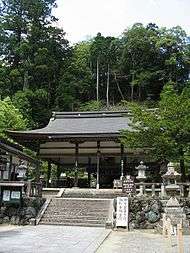Niukawakami Shrine
| Niukawakami Shrine 丹生川上神社 | |
|---|---|
|
| |
 Niukawakami Shrine 丹生川上神社 | |
| Information | |
| Dedicated to | Mizuhanome |
| Founded | 675 |
| Reisai | 16 October |
| Honden style | Nagare-zukuri |
| Address |
968 Ōaza Omura Higashiyoshino Yoshino District Nara prefecture |
| Coordinates | 34°23′25″N 135°59′11″E / 34.39028°N 135.98639°ECoordinates: 34°23′25″N 135°59′11″E / 34.39028°N 135.98639°E |
| Website |
www |
|
| |
Niukawakami Shrine (丹生川上神社 Niukawakami Jinja), also known as Nibukawakami Jinja, is a Shinto shrine located at Higashiyoshino in Nara, Japan.
History
The shrine became the object of Imperial patronage during the early Heian period.[1] In 965, Emperor Murakami ordered that Imperial messengers were sent to report important events to the guardian kami of Japan. These heihaku were initially presented to 16 shrines including the Niukawakami Shrine.[2]
From 1871 through 1946, the Nibukawakami Jinja was officially designated one of the Kanpei-taisha (官幣大社), meaning that it stood in the first rank of government supported shrines.[3]
See also
Notes
- ↑ Breen, John et al. (2000). Shinto in History: Ways of the Kami, pp. 74-75.
- ↑ Ponsonby-Fane, Richard. (1962). Studies in Shinto and Shrines, pp. 116-117.
- ↑ Ponsonby-Fane, Richard. (1959). The Imperial House of Japan, pp. 124.
References
- Breen, John and Mark Teeuwen. (2000). Shinto in History: Ways of the Kami. Honolulu: University of Hawaii Press. ISBN 978-0-8248-2363-4
- Ponsonby-Fane, Richard. (1962). Studies in Shinto and Shrines. Kyoto: Ponsonby Memorial Society. OCLC 399449
- ____________. (1959). The Imperial House of Japan. Kyoto: Ponsonby Memorial Society. OCLC 194887
This article is issued from Wikipedia - version of the 11/15/2016. The text is available under the Creative Commons Attribution/Share Alike but additional terms may apply for the media files.
